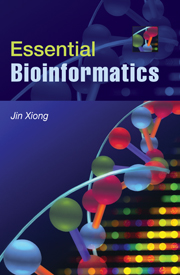Book contents
- Frontmatter
- Contents
- Preface
- SECTION I INTRODUCTION AND BIOLOGICAL DATABASES
- 1 Introduction
- 2 Introduction to Biological Databases
- SECTION II SEQUENCE ALIGNMENT
- SECTION III GENE AND PROMOTER PREDICTION
- SECTION IV MOLECULAR PHYLOGENETICS
- SECTION V STRUCTURAL BIOINFORMATICS
- SECTION V GENOMICS AND PROTEOMICS
- APPENDIX
- Index
- Plate section
- References
2 - Introduction to Biological Databases
Published online by Cambridge University Press: 05 June 2012
- Frontmatter
- Contents
- Preface
- SECTION I INTRODUCTION AND BIOLOGICAL DATABASES
- 1 Introduction
- 2 Introduction to Biological Databases
- SECTION II SEQUENCE ALIGNMENT
- SECTION III GENE AND PROMOTER PREDICTION
- SECTION IV MOLECULAR PHYLOGENETICS
- SECTION V STRUCTURAL BIOINFORMATICS
- SECTION V GENOMICS AND PROTEOMICS
- APPENDIX
- Index
- Plate section
- References
Summary
One of the hallmarks of modern genomic research is the generation of enormous amounts of raw sequence data. As the volume of genomic data grows, sophisticated computational methodologies are required to manage the data deluge. Thus, the very first challenge in the genomics era is to store and handle the staggering volume of information through the establishment and use of computer databases. The development of databases to handle the vast amount of molecular biological data is thus a fundamental task of bioinformatics. This chapter introduces some basic concepts related to databases, in particular, the types, designs, and architectures of biological databases. Emphasis is on retrieving data from the main biological databases such as GenBank.
WHAT IS A DATABASE?
A database is a computerized archive used to store and organize data in such a way that information can be retrieved easily via a variety of search criteria. Databases are composed of computer hardware and software for data management. The chief objective of the development of a database is to organize data in a set of structured records to enable easy retrieval of information. Each record, also called an entry, should contain a number of fields that hold the actual data items, for example, fields for names, phone numbers, addresses, dates. To retrieve a particular record from the database, a user can specify a particular piece of information, called value, to be found in a particular field and expect the computer to retrieve the whole data record.
Information
- Type
- Chapter
- Information
- Essential Bioinformatics , pp. 10 - 28Publisher: Cambridge University PressPrint publication year: 2006
